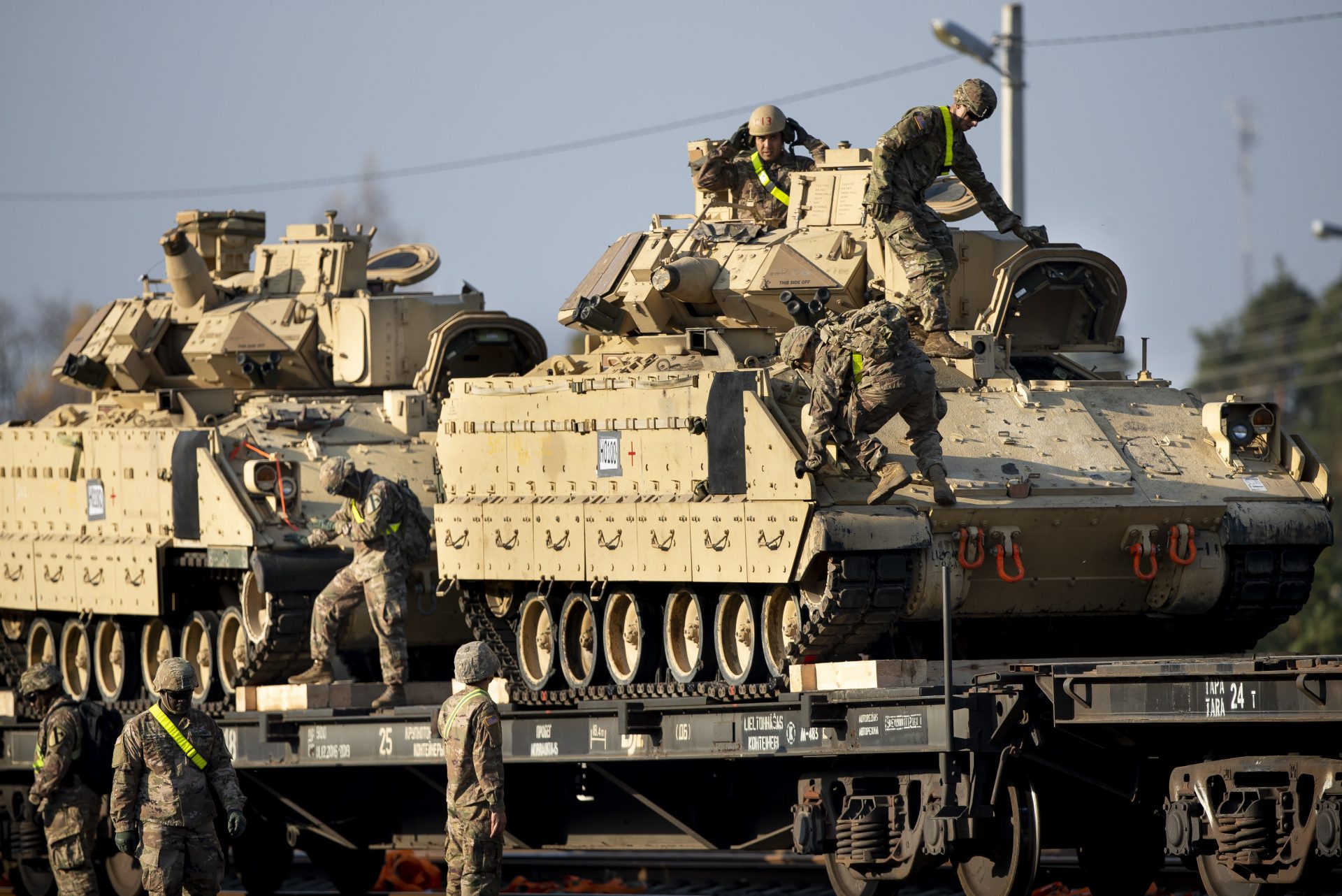Politics, Policy, Political News Top Stories
President Joe Biden says he is considering sending the Army’s primary infantry fighting vehicle to Ukraine. But what Kyiv really wants is Western tanks — and it may be closer than ever to getting its wish.
A decision to send the Bradley Fighting Vehicle, a tracked armored combat vehicle that carries a turret-mounted machine gun, could pave the way for the U.S. and allies to begin providing more powerful Western tanks to Ukraine, something they have so far been reluctant to do, say experts and a U.S. official.
On Wednesday, the same day Biden commented on the Bradleys, France announced that it will send its AMX-10 RC armored fighting vehicles to Kyiv. The AMX-10 is a highly mobile, wheeled system built around a powerful turret-mounted GIAT 105mm gun.
Both factors could make it easier for Western nations to send modern tanks, for instance Germany’s Leopards or even the U.S. Army’s M1 Abrams, said experts and the official, who spoke on condition of anonymity to talk about ongoing discussions.
Western tanks — as opposed to less powerful wheeled vehicles with smaller main guns — would be a game-changer for Kyiv, which already operates Soviet-era tanks from its own inventories and others provided after the invasion by European nations. A Leopard or Abrams is more mobile, accurate and has longer range compared with the old Soviet tanks. They are also more effective at protecting troops than the older tanks or even the Western infantry fighting vehicles as Ukraine continues to suffer large losses on the battlefield.
Indeed, while President Volodymyr Zelenskyy on Wednesday thanked France for the AMX-10, he urged other allies to provide tanks and other heavy weapons.
“There is no rational reason why Ukraine has not yet been supplied with Western tanks,” he said.
Bloomberg first reported that the administration was considering sending Bradleys. The vehicles are designed to work in tandem with the Abrams, providing a “complementary” capability, said retired Lt. Gen. Ben Hodges, a former commander of U.S. Army Europe.
“This is the next step by the administration to provide something that they have been reluctant to do in the past, so this hopefully signals recognition by the administration that the Russians really cannot escalate each time we provide a new capability,” Hodges said.
A Defense Department spokesperson declined to comment.
The Bradley alone would be a significant capability boost for Ukraine. The U.S. has already sent more than 2,000 combat vehicles, including hundreds of mine-resistant vehicles and Humvees that Kyiv has used to push through Russia’s defenses. But the U.S. Army’s gold standard infantry fighting vehicle, the Bradley, is a faster, better-protected update to the M113 armored personnel carrier.
In addition to the 25mm Bushmaster chain gun, it is also armed with two TOW antitank missiles and a 7.62 coaxial machine gun.
“The Brad (or [Infantry Fighting Vehicle]/[Cavalry Fighting Vehicle]) is NOT a tank, but it can be a tank killer,” tweeted retired Lt. Gen. Mark Hertling, also a former commanding general of U.S. Army Europe.
Unlike the Abrams, the Bradley is considered a defensive weapon, making it the less escalatory choice for an administration still concerned about provoking Moscow. But it will be lethal on the battlefield, particularly when paired with Kyiv’s Soviet-era tanks, Hodges said.
“A big part of combined arms warfare is that you have protected infantry that can move alongside tanks, keep up with them, and that’s part of what combined arms is all about: infantry armor artillery,” Hodges said. “By having your infantry moving along with them, that makes it that much more lethal.”
The U.S. Bradley and the French AMX-10, if deployed by the spring in time for renewed Ukrainian offensives in the east, would provide a potent new capability for Ukrainian forces. The AMX-10 has been used as a reconnaissance vehicle and tank killer by French forces in the past, and its high maneuverability and speed would allow Ukraine to hit hard and fast in small engagements. Its relatively light armor is a drawback against heavy Russian guns, however, making speed the key.
“The French vehicle has a lot of firepower, it just doesn’t have a lot of protection,” said Nick Reynolds, a research analyst at the U.K.-based Royal United Services Institute think tank. “It is ultimately a wheeled vehicle which makes it vulnerable, even if it does have fairly good off-road mobility.” The vehicle’s gun can likely take out Russian T-72 tanks and armored infantry carriers, however.
One adviser to the Ukraine government told POLITICO that Washington and Kyiv have been talking for months about sending heavier armor. One of the main sticking points has been identifying which units or storage facilities have the right vehicles available for export, along with some concerns over advanced optical and communications equipment included in newer models.
The Pentagon last month announced an expansion of its training program for Ukrainian forces at a U.S. base in Germany, both in size and scope. The new program will expand training to a battalion’s worth of roughly 500 soldiers a month, and will also include instruction on how to coordinate infantry maneuvering with artillery support, called “combined arms operations.”
If the administration approves sending the Bradleys, the trainees will likely be instructed on how to more effectively maneuver the vehicles alongside existing tanks and infantry. Lighter and more agile than a tank, the Bradley can hold up to 10 soldiers, who will be able to come off the back carrying Javelin antitank missiles, Hodges noted.
For Ukraine, Bradleys and Western tanks can’t come soon enough. Zelenskyy said Tuesday that Russia is planning a second mobilization for a major new offensive early this year. And last month, Gen. Valeriy Zaluzhnyi, Ukraine’s top military leader, told The Economist that he believes Russia could make a push to take Kyiv as soon as January.
Ukrainian officials have been begging for hundreds more tanks, infantry fighting vehicles and howitzers to help repel Russian attacks, particularly strikes on cities and civilian infrastructure.
“We are balancing on a fine line. And if [the power grid] is destroyed … that is when soldiers’ wives and children start freezing,” Zaluzhnyi told The Economist. “What kind of mood the fighters will be in, can you imagine? Without water, light and heat, can we talk about preparing reserves to keep fighting?”
The administration may still be reluctant to send Abrams tanks, however, due to the significant training and logistics involved. Maintenance in the field will be a challenge, especially without a supply of parts. A tank division can also guzzle up to 600,000 gallons of fuel a day, potentially slowing Ukraine’s movement.
The Bradley’s logistical requirements are “terrifically less burdensome than, say, those associated with an M1,” the U.S. official said. “Our M1s would be a logistics burden that we would not want to put on [Ukraine] until they and we were confident they were ready.”
However, Hodges said the training and logistics challenge is “a solvable problem” if the U.S. begins instructing Ukrainian forces on the systems now.
“Let Ukraine pick 100 tankers that are experienced tank mechanics and send them to wherever the U.S. has Abrams tanks in Poland or send them back to Fort Benning, Ga., where the armor school is, and let them start learning now,” he said.
Paul McLeary contributed to this report.
Author Profile
Latest entries
 HeadlinesSeptember 18, 2024Fun Facts: You would have to click a computer mouse 10 million times to burn a single calorie
HeadlinesSeptember 18, 2024Fun Facts: You would have to click a computer mouse 10 million times to burn a single calorie ScienceSeptember 18, 2024Breast milk antibodies protect against rotavirus
ScienceSeptember 18, 2024Breast milk antibodies protect against rotavirus HeadlinesSeptember 18, 2024Top 5 Diddy indictment bombshells: What legal experts predict for future of fallen music mogul
HeadlinesSeptember 18, 2024Top 5 Diddy indictment bombshells: What legal experts predict for future of fallen music mogul ScienceSeptember 18, 2024Low levels of 1 mineral can make IBD worse
ScienceSeptember 18, 2024Low levels of 1 mineral can make IBD worse

